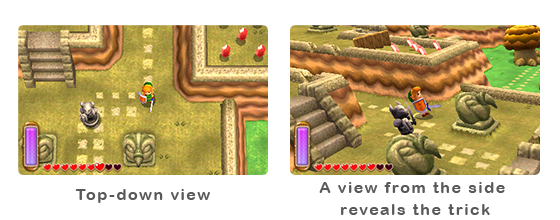Shikata-san and Mouri-san, you were still on the Wii U projects when Miyamoto-san gave the okay on the fourth presentation, weren’t you?
Yes.
But I always had them participate in the presentations. Miyamoto-san said that this would make for a new Zelda game, and then development started in earnest.
We went through a lot of trial and error with the top-down view.
Yeah, we did.
If you looked straight down from the top, all you could see was Link’s hat. So it looked like some mysterious green object moving around! (laughs)
(laughs)
A true top-down view actually has lots of problems. If you make it truthfully, it doesn’t look interesting at all.
That’s right.
So you have to fake it – but in a good way.
Right. We decided to fudge it a bit. Then I was on a speaking session at New York Comic-Con15 in October, and…15. Comic-Con: A cultural event held yearly in cities like New York and San Diego celebrating comics, movies and other forms of entertainment. Nintendo was an exhibitor at the New York Comic-Con in 2013.
You revealed the trick.
Yes. I showed Zelda fans pictures from a side view as well as from above, and it reveals that Link and the Rupees were set at an angle.

I saw those pictures too, that world looked so strange that I wanted to say, “What in the world?!” (laughs)
Yeah. We had purposefully tilted the objects back so you could see Link and the others’ faces and bodies when looking from directly above.
That way, instead of an unrecognisable green object, it looked like Link.
Right! (laughs)
There was also this other challenge that we ended up putting ourselves in a bind.
You mean 60 fps?1616. 60 fps (frames per second): Refreshing the image displayed on the screen 60 times per second.
That’s right. When Mouri-san suddenly asked about doing 60 frames per second, I answered, “What? But 30 frames per second is plenty for The Legend of Zelda!” But he persisted, and when I asked why, he said it stabilises the stereoscopic 3D.
That would be twice the usual number of 30 frames, so the graphics would look smoother.
Yes. As a result, it’s easier for the focus of the stereoscopic 3D to come together. I had them show me the game running in 30 fps as well as in 60 fps and the difference was crystal clear.
Some even say it looks like the screen is shining.
Shining? That doesn’t sound like words that would come out of a programmer.
Well, there’s no basis for that, but… (laughs)
(laughs)
The difference was obvious, so I definitely wanted to do it, but it would be difficult to display the world of The Legend of Zelda at 60 fps.
It could cut in on things like the quality of the art.
Yes. I asked, “If we do that, we’ll be putting ourselves in a bind. Is that all right?” But Mouri-san firmly answered, “It will be all right if we decide to do it from the start.”
It would be difficult to switch to 60 fps partway through, but if you decided on it from the start, you could make the game so as to manage it.
Right.
So I was like, “I’ll leave it up to you!”
Mouri-san, you can be honest, did you ever regret it, even once?
(firmly) Me? Not once.
Oh, that was clear! You have such unwavering determination! (laughs)
It was completely different when I tried it too, so even though I knew it would be hard, I knew we should use 60 fps. I think it was hard on the designers, though.
Ah. The effects spill over to the designers.
Well, us designers also found 60 fps attractive.

You didn’t feel victimised?
No. Even playing with the 3D turned off, it feels completely different.
It’s different even without the stereoscopic 3D?
Yes. With so many frames per second, the movement is smooth when Link swings his sword, and when you beat an enemy, it’s very refined. So we took the idea of making the game 60 fps very positively.
But even as you lightened the processing load, you had to make it look good, so design must have had a hard time.
Well, the programmers had optimised everything for us, so to us it felt like work as usual.
What beautiful teamwork! (laughs)
But perhaps not that beautiful! (laughs)
No no, it was beautiful! (laughs)
Well, let’s leave it at that. (laughs)
(laughs)
What merits arose from the choice to use 60 fps? Aside from stable stereoscopic 3D, smooth sword swings and a shining screen, that is. (laughs)
(laughs) For example, you use the touch screen to change an item, and you set the items by dragging and dropping .
Setting the items is intuitive.
Yes. I actually wanted to do that with Ocarina of Time 3D.
But that was 30 fps.
Because of that we couldn’t do it. At that speed, it can’t keep up with the stylus’s movement. But at 60 fps, it’s really smooth. There were all sorts of other benefits as well, but up until the very end, I was worried it might all fall apart.
But you did it, right?
Right. So I’m absolutely thrilled! (laughs) I think that’s because Mouri-san, who decided on it up front, kept the faith without ever giving up.
I knew it. Beautiful teamwork! (laughs)
(laughs)
© 2024 Nintendo.